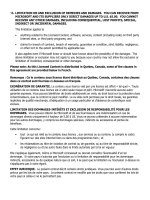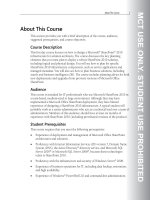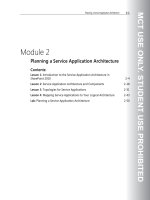Designing a Microsoft SharePoint 2010 Infrastructure Vol 1 part 44 ppt
Bạn đang xem bản rút gọn của tài liệu. Xem và tải ngay bản đầy đủ của tài liệu tại đây (670.15 KB, 10 trang )
MCT USE ONLY. STUDENT USE PROHIBITED
Planning Social Computing 8-49
Defining a Synchronization Schedule
SharePoint 2010 uses two different types of schedule: recurring and nonrecurring.
Recurring schedules support only incremental synchronization, transferring only
changed profile information. Nonrecurring schedules support either incremental
or full synchronization.
Your synchronization plan should begin synchronization with a nonrecurring full
synchronization of user profiles only. When the full synchronization completes,
you can deploy to the production environment and configure a recurring
(incremental) synchronization of both user and group profiles.
A full synchronization can take a significant amount of time to complete,
sometimes days or even weeks. The time that it requires depends on several
factors, such as the number of user or group profiles that you synchronize. The
time that is required to complete an incremental synchronization depends on the
number of profile changes that must be synchronized.
Additional Reading
For more information about how to plan profile synchronization in SharePoint
2010, see
MCT USE ONLY. STUDENT USE PROHIBITED
8-50 Designing a Microsoft® SharePoint® 2010 Infrastructure
Management of Profiles in the Organization
Key Points
To plan for the management of profiles in your organization, you must understand
the User Profile Service architecture and determine who will perform day-to-day
management tasks.
Managing the User Profile Service Architecture
SharePoint 2010 creates three databases for storing user profile information and
associated data:
• A profile database. This stores user profile information.
• A synchronization database. This stores configuration and staging information.
The User Profile Synchronization Service uses this information for
synchronizing profile data from external sources—such as Active Directory—
and LOB applications.
• A social tagging database. This stores the social tags and notes that users create.
Each social tag and note is associated with a profile ID.
MCT USE ONLY. STUDENT USE PROHIBITED
Planning Social Computing 8-51
SharePoint sites, My Site Web sites, and team sites access each of these databases
by using the User Profile Service. This provides a dynamic, personalized
experience for the users in an organization.
Your plan for managing social computing should include a plan for managing and
monitoring these databases.
Managing the User Profile Service
The approach that you take to managing the User Profile Service will vary
depending on the nature of your organization. In small organizations, a single
administrator can manage all areas of the User Profile Service. In larger or more
complex organizations, you can isolate areas for management by different
administrators who do not need to know about the existence of other areas of the
service. For example, one administrator can manage My Site Web sites and a
different administrator can manage social tags and notes. You can restrict the User
Profile Service to certain departments or sets of sites based on business
requirements, security restrictions, and budgets.
Managing Supporting Services
The User Profile Service relies on other shared services to implement the full range
of social computing features in SharePoint 2010. These related shared services
include:
• The Managed Metadata Service, which supports the use of managed metadata
and shared content types across site collections and Web applications.
• The Search Service, which is required to enable People Search functionality.
Question: Which databases does the User Profile Service use?
MCT USE ONLY. STUDENT USE PROHIBITED
8-52 Designing a Microsoft® SharePoint® 2010 Infrastructure
Business Connectivity Services
Key Points
Many organizations use information that is stored in business systems such as
Siebel or SAP. SharePoint 2010 supports BCS, a set of services and features that
provide a way to connect SharePoint 2010 to sources of external data. Planning for
BCS should include determining the nature of the solutions that your organization
requires and planning for the security and administration of these solutions.
You administer BCS primarily by using the Business Data Connectivity Service.
SharePoint 2010 imports profile information that is stored in business systems by
using the Business Data Connectivity Service. The User Profile Synchronization
Service adds this data to the existing information that is imported from Active
Directory or other directory services. For example, if a profile that contains the
name and employee number for a user exists in the SharePoint 2010 profile store,
you can augment this information with the hire date for that employee from
another business system. To do this, you must plan for the configuration of the
Business Data Connectivity Service, so that you can to connect to the business
systems that you have identified.
MCT USE ONLY. STUDENT USE PROHIBITED
Planning Social Computing 8-53
Although you can import data from business systems, the User Profile
Synchronization Service does not support the export of profile properties to
business systems.
Additional Reading
For more information about how to plan for BCS in SharePoint 2010, see
MCT USE ONLY. STUDENT USE PROHIBITED
8-54 Designing a Microsoft® SharePoint® 2010 Infrastructure
Lab: Planning Social Computing
Exercise 1: Planning User Profiles
Scenario
Based on the organization’s business requirements, you must plan which user
profile properties to synchronize with Active Directory Domain Services. The
information that your team needs is detailed in the supplied documents. Use these
documents to produce your user profile property synchronization plan.
The main tasks for this exercise are as follows:
1. Read the supporting information.
2. Complete the User Profile Property Planning worksheet.
f Task 1: Read the supporting information
1. Read the lab scenario.
MCT USE ONLY. STUDENT USE PROHIBITED
Planning Social Computing 8-55
2. Log on to 10231A-NYC-DC1-08 as CONTOSO\Ed with the password
Pa$$w0rd.
3. In the E:\Labfiles\Lab08\Starter folder, read the information in the User
Profile Requirements.docx file.
f Task 2: Complete the User Profile Property Planning worksheet
• In the E:\Labfiles\Lab08\Starter folder, complete the worksheet in the User
Profile Property Planning Worksheet.xlsx file.
Exercise 2: Configuring User Profile Synchronization
Scenario
You must now perform the configuration tasks that are necessary to implement
your plan. You will also verify that the correct user profiles are synchronized.
The main tasks for this exercise are as follows:
1. Configure Active Directory permission for synchronization.
2. Create a synchronization connection and a connection filter.
3. Run the user profile import.
4. Confirm the user profile synchronization by checking that the Ed Meadows
and Adam Carter profiles were imported and that the Neil Charney profile was
not imported.
5. Provision Ed Meadows’ My Site Web site.
f Task 1: Configure Active Directory permission for synchronization
1. In Active Directory Users and Computers, delegate control of the Contoso.com
domain to the SharePoint farm account. Use the information in the following
table to complete the Delegation of Control Wizard.
Option Value
Users and Groups sp-farm
Tasks to Delegate Create a custom task to delegate
MCT USE ONLY. STUDENT USE PROHIBITED
8-56 Designing a Microsoft® SharePoint® 2010 Infrastructure
Option Value
Active Directory Object
Type
This folder, existing objects in this folder, and
creation of new objects in this folder
Permissions General
Replicating Directory Changes
2. Verify that the user account for Neil Charney (in the Production
Organizational Unit) is disabled.
f Task 2: Create a synchronization connection and a connection filter
1. In SharePoint 2010 Central Administration, under Application Management,
click Manage service applications, and then click User Profile Service
Application.
2. Under Synchronization, click Configure Synchronization Connections.
3. Create a new connection for the User Profile Service application. Use the
information in the following table to configure the new connection.
Option Value
Connection Name Contoso
Forest name Contoso
Account name contoso\sp-farm
Password Pa$$w0rd
Populate Containers IT, Marketing, and Production
4. Edit the new Contoso connection to create a filter that excludes disabled user
accounts. Use the information in the following table to add the filter for users.
Option Value
Attribute userAccountControl
Operator Bit on equals
Filter 2
MCT USE ONLY. STUDENT USE PROHIBITED
Planning Social Computing 8-57
f Task 3: Run the user profile import
1. In SharePoint 2010 Central Administration, start the User Profile Service
application.
2. Refresh the page, watching the Profile Synchronization Status as the
synchronization proceeds.
3. When the Profile Synchronization Status returns to Idle, click Idle to view the
synchronization report.
f Task 4: Confirm the user profile synchronization by checking that the
Ed Meadows and Adam Carter profiles were imported and that the
Neil Charney profile was not imported
1. In SharePoint 2010 Central Administration, on the Manage Profile Service:
User Profile Service Application page, under People, click Manage User
Profiles.
2. Find and view the user profiles for Ed Meadows and Adam Carter.
3. Attempt to locate the user profile for Neil Charney. This user account is
disabled, so the profile has not been imported. Therefore, the search result is
empty.
f Task 5: Provision Ed Meadows’ My Site Web site
1. In SharePoint 2010 Central Administration, create a My Site Web site for Ed
Meadows.
2. Wait for the page to be created.
3. To verify that the My Site has been created, view the My Content and My
Profile pages.
MCT USE ONLY. STUDENT USE PROHIBITED
8-58 Designing a Microsoft® SharePoint® 2010 Infrastructure
Module Review and Takeaways
Review Questions
1. What are the services that support My Site Web sites?
2. How can you help to secure personal information on My Site Web sites?
3. What functionality does BCS provide for social computing?
Best Practices Related to Social Computing
Supplement or modify the following best practices for your own work situations:
• Social computing is about finding people and expertise. If you provide users
with a quick and easy way to find what they need, it will become self-
perpetuating, with users adding and maintaining their own content.









